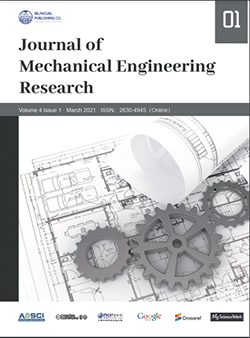Precision Engineering Design Process for Optimal Design Based on Engineering Sciences
DOI:
https://doi.org/10.30564/jmer.v4i1.2889Abstract
Concepts of precision engineering design process for optimal design where engineering sciences contribute in the successful good design are elaborated in this paper. Scientific theory and practicality are discussed in this paper. Factors necessary for a complete product or systems design are detailed and application of mathematical design optimization in producing a good design are shown. Many applicable engineering design examples are itemized to show relevancy of the optimal design theory to engineering design. Future trends of optimal design with respect to the 4th industrial revolution of digitization are presented. Paper sets to elaborate that most of the engineering and scientific design problems can be optimized to a good design based on many new/advanced optimization techniques.
Keywords:
Optimal design, Good Design, Optimization of design, Digitization in designReferences
[1] Accreditation Board of Engineering and Technology (2020), Criteria for Accrediting Engineering Programs-2019-2020, http://www.abet.org/accreditation/ accreditation-criteria/criteria-for-accrediting-engineering-programs-2019-2020/#GC5
[2] Ertas, A. & Jones, J. (1996), The Engineering Design Process. 2nd ed. John Wiley & Sons, Inc., New York, N.Y.
[3] Altringer, B., & Habbal, F. (2015), Embedding Design Thinking in a Multidisciplinary Engineering Curriculum. In National Collegiate Inventors and Innovators Alliance (pp. 1–13). Hadley, Massachusetts. Retrieved from http://search.proquest.com/ docview/1749280842?accountid=14701nhttp://sfx.scholarsportal.info/ottawa?url_ver=Z39.88- 2004&rft_val_fmt=info:ofi/fmt:kev:mtx:journal&- genre=article&sid=ProQ:ProQ:entrepreneurship&atitle=EMBEDDING+DESIGN+THINKING+IN+A+- MULTIDISC--
[4] Melissa T. Greene, Richard Gonzales, Panos Y. Papalambros and Anna-Maria McGowan (2017), Design Thinking vs. System Thinking for Engineering Designs: What’s the difference, 21st International Conference on Engineering Design, Vancouver, Canada.
[5] Forrester, Jay. (1994), System Dynamics, Systems Thinking and Soft OR, System Dynamics Review, Vol. 10(2) pp. 1-14. DOI: https://doi.org/10.1002/sdr.4260100211
[6] Ludwig Von Bertalanffy (1940), An Outline of General Systems Theory, British Journal for the Philosophy of Science, Vol. 1 (2) pp. 134-165. DOI: https://doi.org/10.1177/053901846700600610
[7] Georgios Kazakis, Ioannis Kanellopoulos, Stefanos Sotiropoulos, Nikos D. Lagaros (2017), Topology optimization aided structural design: Interpretation, computational aspects and 3D printing. Heliyon, Vol. 3 e00431. DOI: https://doi.org/10.1016/j.heliyon.2017.e00431
[8] L. Spunt (1971), Optimum Structural Design, Prentice-Hall, Englewood Cliffs, New Jersey, USA.
[9] Jan N. Snyman (2005), Practical Mathematical Optimization, Springer Science+Business Media, Inc.
[10] Bahri Sahin, Yasin Ust, Ismail Teke and Hasan Huseyin Erdem (2010), Performance analysis and optimization of heat exchangers: a new thermoeconomic approach, Journal of Applied Thermal Engineering, Vol. 30, Issues 2–3, pp. 104-109. DOI: https://doi.org/10.1016/j.applthermaleng.2009.07.004
[11] Cezarina, Afteni and Frumuşanu, Gabriel (2017) A Review on Optimization of Manufacturing Process Performance, International Journal of Modeling and Optimization, Vol. 7(3): 139-144. DOI: https://doi.org/10.7763/IJMO.2017.V7.573
[12] Wei Li, Mi Xiao and Liang Gao (2019), Improved Collaboration Pursing Method for Multidisciplinary Robust Design Optimization, Structural and Multidisciplinary Optimization Journal, pp. 1949-1968. DOI: https://doi.org/10.1007/s00158-018-2165-2
[13] Wang X, Wang R, Chen X and Geng X (2018), An efficient single loop strategy for reliability-based multidisciplinary design optimization under non-probabilistic set theory, Aerospace Science Technology, Vol. 73: 148-163. https://doi.org/10.1016/ j.ast.2017.11.046.
[14] Zaman K and Mahadevan S (2013), Robustness-based design optimization of multidisciplinary system under epistemic uncertainty, American Institute of Aeronautics and Astronautics Journal Vol. 51(5): 1021-1031. DOI: https://doi.org/10.2514/1.J051372
[15] Martin O. Bendose and N Kikuchi (1988), Generating Optimal topologies in structural design using a homogenization method, Journal of Computational Method Appl Mech Engr, Vol. 71: 197-224. DOI: http://dx.doi.org/10.1016/0045-7825(88)90086-2
[16] Il Yong Kim and Byung Man Kwak (2002), Design Space Optimization using a Numerical Design Continuation Method, International Journal for Numerical Methods in Engineering, Vol. 53: 1979-2002. DOI: http://dx.doi.org/10.1002/nme.369
[17] Raino A.E. Makinen, Jacques Periaux and Jari Toivanen (1999), Multidisciplinary Shape Optimization in Aerodynamics, electromagnetics using genetic algorithms, Int Journal for Numerical Methods in Fluid, Vol. 30: 149-159. DOI: https://doi.org/10.1002/(SICI)1097- 0363(19990530)30:23.0.CO;2-B
[18] C. Onwabiko (2000), Introduction to Engineering Design Optimization, Prentice Hall, U.S.A.
[19] Wang, F.S., Chen, L.H. (2013), Heuristic Optimization, Encyclopedia of Biology Systems, Springer, New York NY.
[20] Pahl, G., Beitz, W., Feldhusen, J. and Grote, K-H. (2007), Engineering Design: A Systematic Approach, Springer, New York NY.
[21] Pugh, S. (1991), Total Design: Integration Methods for Successful Product Engineering, University of Michigan, Ann Arbor, Michigan.
[22] Company Blog, (2019), How digitalisation is changing the world of engineering, Item Industrietechnik GmbH, Germany.
[23] Zhou, J., (2013), Digitalization and intelligentization of manufacturing industry. Adv. Manuf. 1, 1-7.
Downloads
Issue
Article Type
License
Copyright © 2021 Amir Javidinejad

This is an open access article under the Creative Commons Attribution-NonCommercial 4.0 International (CC BY-NC 4.0) License.




 Amir Javidinejad
Amir Javidinejad

